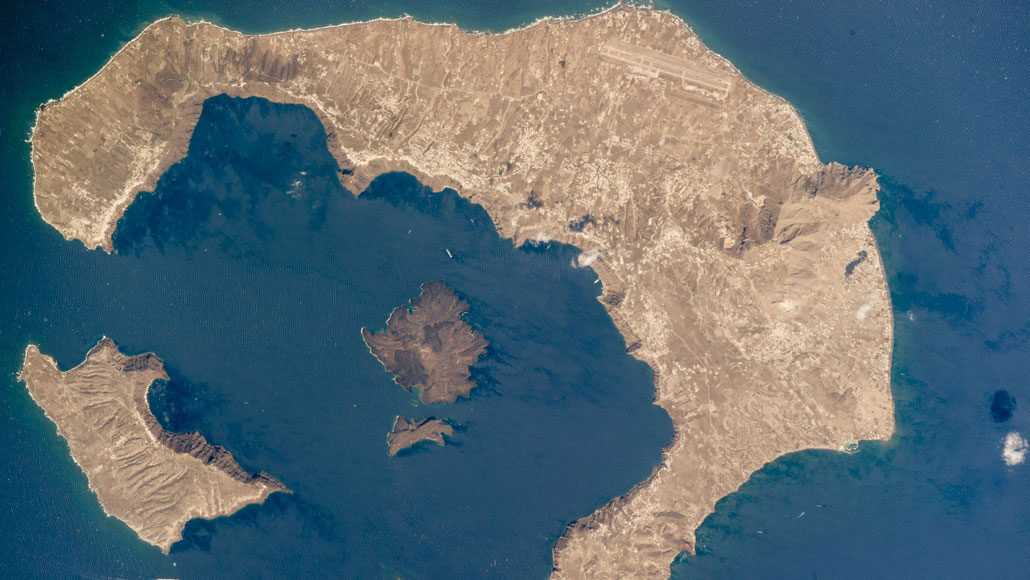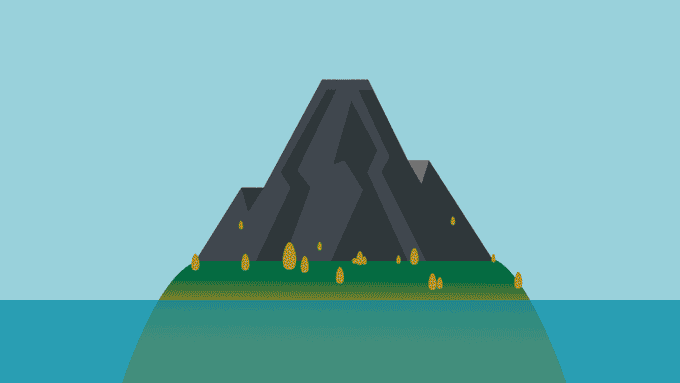Lower sea levels over the last 360,000 years are linked with more eruptions

Sea level seems to influence eruptions from the partially-submerged volcano of Santorini in Greece (pictured). Lower sea levels are historically linked to more eruptions.
NASA EARTH OBSERVATORY
By Maria Temming
14 HOURS AGO
When sea level drops far below the present-day level, the island volcano Santorini in Greece gets ready to rumble.
A comparison of the activity of the volcano, which is now partially collapsed, with sea levels over the last 360,000 years reveals that when the sea level dips more than 40 meters below the present-day level, it triggers a fit of eruptions. During times of higher sea level, the volcano is quiet, researchers report online August 2 in Nature Geoscience.
Other volcanoes around the globe are probably similarly influenced by sea levels, the researchers say. Most of the world’s volcanic systems are in or near oceans.
“It’s hard to see why a coastal or island volcano would not be affected by sea level,” says Iain Stewart, a geoscientist at the Royal Scientific Society of Jordan in Amman, who was not involved in the work. Accounting for these effects could make volcano hazard forecasting more accurate.
Santorini consists of a ring of islands surrounding the central tip of a volcano poking out of the Aegean Sea. The entire volcano used to be above water, but a violent eruption around 1600 B.C. caused the volcano to cave in partially, forming a lagoon. That particular eruption is famous for potentially dooming the Minoan civilization and inspiring the legend of the lost city of Atlantis (SN: 2/1/12).
To investigate how sea level might influence the volcano, researchers created a computer simulation of Santorini’s magma chamber, which sits about four kilometers beneath the surface of the volcano. In the simulation, when the sea level dropped at least 40 meters below the present-day level, the crust above the magma chamber splintered. “That gives an opportunity for the magma that’s stored under the volcano to move up through these fractures and make its way to the surface,” says study coauthor Christopher Satow, a physical geographer at Oxford Brookes University in England.
According to the simulation, it should take about 13,000 years for those cracks to reach the surface and awaken the volcano. After the water rises again, it should take about 11,000 years for the cracks to close and eruptions to stop.

When the sea drops at least 40 meters below the present-day level, the crust beneath the Santorini volcano (illustrated) starts to crack. As the sea level drops even further over thousands of years, those cracks spread to the surface, bringing up magma that feeds volcanic eruptions.
OXFORD BROOKES UNIVERSITY
It may seem counterintuitive that lowering the amount of water atop the magma chamber would cause the crust to splinter. Satow compares the scenario to wrapping your hands around an inflated balloon, where the rubber is Earth’s crust and your hands’ inward pressure is the weight of the ocean. As someone else pumps air into the balloon — like magma building up under Earth’s crust — the pressure of your hands helps prevent the balloon from popping. “As soon as you start to release the pressure with your hands, [like] taking the sea level down, the balloon starts to expand,” Satow says, and ultimately the balloon breaks.
Satow’s team tested the predictions of the simulation by comparing the Santorini Volcano’s eruption history — preserved in the rock layers of the islands surrounding the central volcano tip — with evidence of past sea levels from marine sediments. All but three of the volcano’s 211 well-dated eruptions in the last 360,000 years happened during periods of low sea level, as the simulation predicted. Such periods of low sea level occurred when more of Earth’s water was locked up in glaciers during ice ages.
“It’s really intriguing and interesting, and perhaps not surprising, given that other studies have shown that volcanoes are sensitive to changes in their stress state,” says Emilie Hooft, a geophysicist at the University of Oregon in Eugene, who wasn’t involved in the work. Volcanoes in Iceland, for instance, have shown an uptick in eruptions after overlying glaciers have melted, relieving the volcanic systems of the weight of the ice.
Volcanoes around the world are likely subject to the effects of sea level, Satow says, though how much probably varies. “Some will be very sensitive to sea level changes, and for others there will be almost no impact at all.” These effects will depend on the depth of the magma chambers feeding into each volcano and the properties of the surrounding crust.
But if sea level controls the activity of any volcano in or near the ocean, at least to an extent, “you’d expect all these volcanoes to be in sync with one another,” Satow says, “which would be incredible.”
As for Santorini, given that the last time sea level was 40 meters below the present-day level was about 11,000 years ago — and sea level is continuing to rise due to climate change — Satow’s team expects the volcano to enter a period of relative quiet right about now (SN: 3/14/12). But two major eruptions in the volcano’s history did happen amid high sea levels, the researchers say, so future violent eruptions aren’t completely off the table.
It may seem counterintuitive that lowering the amount of water atop the magma chamber would cause the crust to splinter. Satow compares the scenario to wrapping your hands around an inflated balloon, where the rubber is Earth’s crust and your hands’ inward pressure is the weight of the ocean. As someone else pumps air into the balloon — like magma building up under Earth’s crust — the pressure of your hands helps prevent the balloon from popping. “As soon as you start to release the pressure with your hands, [like] taking the sea level down, the balloon starts to expand,” Satow says, and ultimately the balloon breaks.
Satow’s team tested the predictions of the simulation by comparing the Santorini Volcano’s eruption history — preserved in the rock layers of the islands surrounding the central volcano tip — with evidence of past sea levels from marine sediments. All but three of the volcano’s 211 well-dated eruptions in the last 360,000 years happened during periods of low sea level, as the simulation predicted. Such periods of low sea level occurred when more of Earth’s water was locked up in glaciers during ice ages.
“It’s really intriguing and interesting, and perhaps not surprising, given that other studies have shown that volcanoes are sensitive to changes in their stress state,” says Emilie Hooft, a geophysicist at the University of Oregon in Eugene, who wasn’t involved in the work. Volcanoes in Iceland, for instance, have shown an uptick in eruptions after overlying glaciers have melted, relieving the volcanic systems of the weight of the ice.
Volcanoes around the world are likely subject to the effects of sea level, Satow says, though how much probably varies. “Some will be very sensitive to sea level changes, and for others there will be almost no impact at all.” These effects will depend on the depth of the magma chambers feeding into each volcano and the properties of the surrounding crust.
But if sea level controls the activity of any volcano in or near the ocean, at least to an extent, “you’d expect all these volcanoes to be in sync with one another,” Satow says, “which would be incredible.”
As for Santorini, given that the last time sea level was 40 meters below the present-day level was about 11,000 years ago — and sea level is continuing to rise due to climate change — Satow’s team expects the volcano to enter a period of relative quiet right about now (SN: 3/14/12). But two major eruptions in the volcano’s history did happen amid high sea levels, the researchers say, so future violent eruptions aren’t completely off the table.
No comments:
Post a Comment